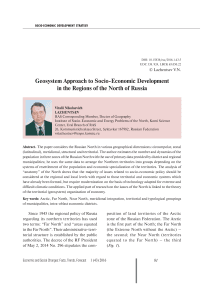Geosystem approach to socio-economic development in the regions of the north of Russia
Автор: Lazhentsev Vitalii Nikolaevich
Журнал: Economic and Social Changes: Facts, Trends, Forecast @volnc-esc-en
Рубрика: Socio-economic development strategy
Статья в выпуске: 1 (43) т.9, 2016 года.
Бесплатный доступ
The paper considers the Russian North in various geographical dimensions: circumpolar, zonal (latitudinal), meridional, structural and territorial. The author estimates the number and dynamics of the population in three zones of the Russian North with the use of primary data provided by district and regional municipalities; he uses the same data to arrange the Northern territories into groups depending on the systems of resettlement of the population and economic specialization of the territories. The analysis of “anatomy” of the North shows that the majority of issues related to socio-economic policy should be considered at the regional and local levels with regard to those territorial and economic systems which have already been formed, but require modernization on the basis of technology adapted for extreme and difficult climatic conditions. The applied part of research on the issues of the North is linked to the theory of the territorial (geosystem) organization of economy.
Arctic, far north, near north, meridional integration, territorial and typological groupings of municipalities, intra-oblast economic districts
Короткий адрес: https://sciup.org/147223810
IDR: 147223810 | УДК: 338. | DOI: 10.15838/esc/2016.1.43.5
Текст научной статьи Geosystem approach to socio-economic development in the regions of the north of Russia
Since 1945 the regional policy of Russia regarding its northern territories has used two terms: “Far North” and “areas equated to the Far North”. Their administrative-territorial structure is established by the public authorities. The decree of the RF President of May 2, 2014 No. 296 stipulates the com- position of land territories of the Arctic zone of the Russian Federation. The Arctic is the first part of the North; the Far North (the Extreme North without the Arctic) – the second; the Near North (territories equated to the Far North) – the third (Fig. 1).
Figure 1. Latitudinal projection of the Russian North
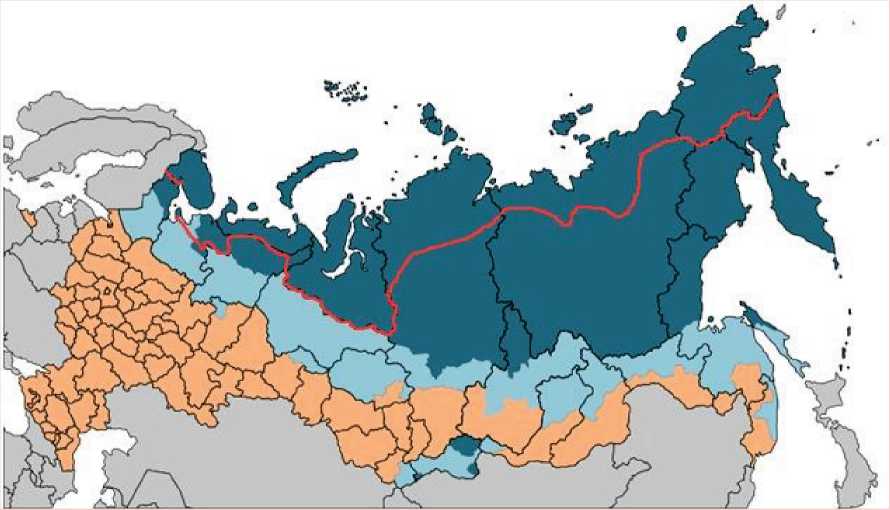
■ Far North regions
Areas equated to the Far North
The red line shows a land boundary of the Arctic zone of the Russian Federation in accordance with the Presidential Decree of 4 May 2014 No. 296.
The Arctic is a special area of geopolitical relations aimed at peaceful resolution of the issues to develop its mineral and biological resources and creation of transport communications with the use of the Northern Sea Route. In the given geopolitics Russia focuses on the legislative and normative regulation of social (especially life of the indigenous peoples of the North) and economic activity, including environmental protection. In 2015 the State Commission on Arctic Development was set up; the report “On state and problems of the legislative support of realization of the Strategy for development of the Arctic zone of the Russian Federation and national security for the period up to 2020” is made annually.
The Strategy primarily takes into account the Arctic nature characteristics: low radiation balance, close to 0 °C average temperature in summer months with negative average annual temperature, existence of glaciers and permafrost, predominance of tundra vegetation and Arctic deserts. Due to the actualization of the climatic factor in the mankind development the experts say that the Arctic climate have, indeed, fluctuated significantly over the last 600 years. During this time period there were at least 3 or 4 significant warmings, but that (according to many opinions) was completely determined by the change in natural factors, primarily the Earth rotational rate, solar activity and the atmospheric circulation nature.
The geopolitical aspect of the Arctic thematic substantiates the necessity of its consideration in the circumpolar projection in order to position the Russian Arctic in the international cooperation with the mobilization of scientific and technological potential of many countries and the establishment of the legal order that equally protects the interests of each country. It is the Russian part of the Arctic that is most populated and developed. In 2010 in the Arctic zone of the Earth 4,238 thousand people lived, the Russian Arctic– 2,080, the Arctic Europe – 1,280, and the American Arctic – 827 thousand people. In the land territories of the Russian Arctic zone, established by the Presidential Decree of May 2, 2014 No. 296, the population amounted to 2,383 thousand people at the beginning of 2015.
Russia occupies high positions not only in social, but also natural-resource potential of the world Arctic. Here there are economic complexes with the almost-complete network of settlements that serve as the basis for development of the Arctic Ocean resources. Total reserves of oil and gas in the national Arctic sectors are distributed as follows (in billion tons of conditional fuel): Iceland – 16, Alaska (USA) – 40, Canada – 61, Denmark– Greenland–Faroe Islands – 65, Norway – 65, Russia – 105 (by estimations of national energy agencies). In the Arctic zone about
80% of Russian gas, more than 90% of nickel and cobalt, 60% of copper, 96% of platinumgroup metals, and 100% of barite are extracted. The important role in food security of the population is played by fish and other marine bioresources1.
There are conflicts about the Arctic Ocean resources use among the countries adjacent to the Arctic. But the situation is not a matter for political-military tension; it is considered in the framework of normal international relations [2]. D.A. Dodin believes that the Circumpolar Arctic zone can be considered as an object of international programs for sustainable development [1]. Moreover, A.N. Pilyasov states that over time around the Arctic Ocean, as once around the Mediterranean Sea, a global cooperation with general features of economic behaviour will form [6]. Yu.F. Lukin relies on the identity of peoples of the Arctic countries as a factor in economic order and social justice [5].
Biologists have shown that risks and threats to the Arctic development are largely linked to the unfavourable dynamics of vegetation cover of the tundra. Metabolism of tundra biosystems has changed for the worst in terms of biomass growth, overgrowing of large areas of mosses and lichens by shrubs, and the accelerated process of eutrophication. Science poses the problem of the fodder base for reindeer husbandry and emphasizes that its decision should be primarily based on fundamental research in the tundra as a unique natural area. Modernization of reindeer herding is associated with provision of the industry with necessary structures, equipment, means of communication, transport, creation of a base for deer hides processing, production of high-value and high-yield endocrine-enzyme raw materials, which are in great demand abroad.
The issue about the development of shelf and remote seas of the Arctic Ocean is particularly problematic. N.P. Laverov, studying the Arctic problems, pays special attention to the technology of extraction, transportation and processing of oil and gas. The Academician rightly points out that haste in the industrial development without radical technological modernization often leads to huge losses [3]. Not accidentally, “the companies “Rosneft”, “Gazprom Neft” and “Novatek” have applied to the RF Government with the request to postpone the commissioning of 29 new oil fields with total extraction of over 26 million tons per year”2.
As the Arctic is officially considered as a specific object of state policy, it would be useful to define status positions in terms of forms of government regulation of socio-economic activities and maintenance of a proper quality of life. It is necessary to formalise the difference of the Arctic from regions of the Far and Near North. Thus, it is justified to strengthen the Arctic vector of regional policy of the federal government, especially in terms of improving economic regulators of economic activity, objective assessment of a living wage, retirement security, resettlement guarantees, state support of family and childhood, life activities of the indigenous peoples of the
North, and socially equitable distribution of natural resource rents [8].
In this regard, we note the following. The Presidential Decree of May 2, 2014 No. 296 stipulates the minimum boundaries and composition of land territories of the RF Arctic zone to focus on solving current issues regarding strengthening of defence capacity in this geopolitical sector of our country, creation of coastal infrastructure of the Northern Sea Route, exploration and initial development of shelf resources of the Arctic Ocean. However, to address the problems of socio-economic development of the high-latitude territories Russia’s Arctic zone should be studied in other, specified borders; moreover, it is necessary to harmonize the legislation and regulations relating to the Far North and “anew identified Arctic”. The latter includes, for example, the Arkhangelsk Oblast, where Arkhangelsk and 3 other municipal districts in the mentioned decree are referred to the Arctic, but not to the Far North. It turns out that the Arctic includes 6 districts of the Arkhangelsk Oblast, only 5 districts of the Sakha (Yakutia) Republic, and the city of Vorkuta of the Komi Republic. The Northern subjects’ desire to enter the Arctic zone is reasonable and fair. This primarily concerns the Komi Republic (Intinsky and Usinsky districts) and the Sakha (Yakutia) Republic, where the districts (ulus), fully or partially lying norther than 65 degrees north latitude, of course, are Arctic.
The Far North is a high latitude zone of Russia, characterized as the Continental Far North (except for the part adjacent to cold seas of the Pacific Ocean), that has not less harsh climate than land territories of the Arctic, more significant remoteness from transport highways, and, at the same time, extensive experience in the development of mineral resources and organization of mining, fishing and agriculture.
The problems of this area development are largely related to the mining industry upgrade. Only new technologies can extend the life of “old” ore, coal and oil fields, including application of hydrochemical methods of mineral resources extraction.
The state regulation of socio-economic development of the Far North regions is completely “covered” by regulatory and legal framework of the Extreme North. Here it is not so much about the creation of new regulators, but, to a greater extent, the proper implementation of already existing ones.
The Near North is the most habitable natural-economic zone among northern territories. Its area is home to 58% of the Russian North population. The problems of its economic development in terms of oil and gas and mining complexes are approximately the same as those of the Far North. However, the biological resource complex is specific. It is leading for many regions of the Near North. Experts believe that besides traditional wood processing it is very promising to promote bioconservation of cellulosic feedstock for production of valuable biological products and technically important products. For example, the cultivation of wood-destroying fungi on cellulosic wastes (sawdust, shavings, bark) helps obtain feed additives for livestock; production of glucose by enzymatic hydrolysis of cellulose is also very economically profitable and ecologically expedient. The use of cell cultures as producers in biotechnology gives an opportunity to produce a wide range of plant biopolymers and bottom amolecular bioregulators. Dendrochemistry also “claims” for processing the entire wood biomass, including production of alcohol, turpentine, provitamin concentrate, conifer and essential oils, balsamic pasta, pine wax, polyprenols, etc. The rural energy development prospects are connected with the use of wood waste.
Agriculture of the Near North needs modernization, aimed at the formation of adaptive-landscape systems agriculture based on modern agricultural technologies. The attraction of rural households and country estates technical progress is an important aspect of modernization. They should be provided with mechanization means. In addition, it is advisable to organize technical stations for the general use (rental of equipment and mechanisms) in rural areas. Small forms of agriculture can be more susceptible (compared with large enterprises) to the application of new technologies: domestic row-band and Dutch methods of planting potato, the Finnish method of growing seedlings and planting cabbage, and storage of fruits using ice as a construction material of storages, etc.
The Near North industry differs little from this sector of non-northern Russian regions by territorial-economic characteristics. It also is dominated by large enterprises, included into the structure of transnational and national corporations, little correlated with small and medium enterprises and the domestic scientific-technological sector. This important economic function of the Near North, such as establishment of industrial, scientific and educational bases for the entire North, including the Arctic, is fulfilled very poorly and without target program provision.
The legal specifics of the Near North are fixed in the concept “areas equated to the Far North”. The set standards and correction factors in terms of income are quite sufficient regarding their conformity to the degree of appreciation of costs for life support. Northern allowances should be fixed for the Vologda Oblast districts, which border with the Arkhangelsk Oblast (Veliky Ustyug is Ded Moroz’ residence); the Kirov Oblast districts, located close to Kotlas; northern districts of the Sverdlovsk Oblast (in the same way as it is done for the north of the Perm Oblast).
The North in general consists of 13 subjects of the Russian Federation and certain territories of 11 subjects. Their area amounts to 12.6 million km2 (2/3 of the country); their population – about 10 million people (7% of the population), including about 350 thousand people classified as minorities, and 1,250 thousand people – as indigenous peoples ( tab. 1; fig. 2 ).
Table 1. Area and population of the Russian North and northern natural-economic zones*
|
Zone |
Area, thousand km2 |
Population, thousand people |
Dynamics, % |
|||||
|
1990 |
2000 |
2010 |
2015 |
2015 in % to 2010 |
2015 in % to 2000 |
2015 in % to 1990 |
||
|
Russian North |
12,654 |
12,418 |
11,011 |
10,153 |
9,954 |
98 |
90 |
80 |
|
Including: Arctic |
4,328 |
3,178 |
2,664 |
2,431 |
2,383 |
98 |
89 |
75 |
|
Far North |
5,144 |
2,432 |
2,084 |
1,870 |
1,823 |
97 |
87 |
75 |
|
Near North |
3,182 |
6,808 |
6,263 |
5,852 |
5,748 |
98 |
92 |
84 |
* Calculated by the author on the basis of data of “Wikipedia” (Internet) and district municipalities with the use of reference materials of the Census of the Russian Federation in 1989 and 2010; given rounded to the nearest thousand.
Figure 2. Russian North: area (thousand km2) and population (thousand people), 2015
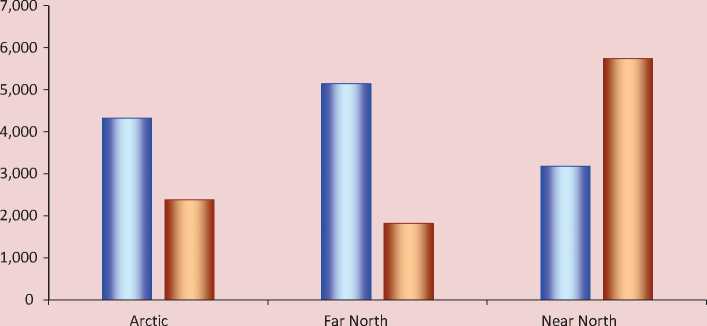
□ Area, thousand square km П Population, thousand people
Massive outflow of the population is the most impressive process that encourages reflections about the future of the Russian North ( fig. 3 and 4 ).
In 1990–2015 the population of the Russian North decreased by 2,464 thousand people, or 20%, including: in the Euro- pean part – by 27%, in the North of Eastern Siberia – 17, the Far East – 38%; in the North of Western Siberia population increased by 17%. Against this general background northeastern “corners” seem negative: in the Komi Republic the population declined by 28%, the Magadan Oblast – 62%, and Chukotka
Figure 3. Population dynamics by zones of the Russian North, %

^^— Arctic
^^— Far North
^^— Near North
^^— North in general
1990 2000 2010 2015
Figure 4. Population dynamics by sectors of the Russian North
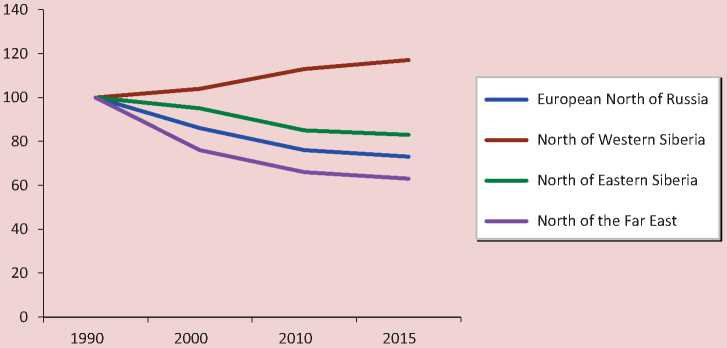
Autonomous Okrug – 69%. The European North of Russia is losing its population faster than the North of Eastern Siberia due to close location to the regions with more favorable climatic and social conditions.
Let us note that the migration processes occur amid positive developments in the reproductive behavior of population and the growth of fertility. In the regions of the European and Asian North the year of 2013 was a turning point: the birth rate exceeded the death rate; besides, there is a rise in migration and mobility. People move out the North and around it. The percentage of migrants from Central Asia countries increases.
Though each person finds his/her own reasons to leave northern regions, there are common grounds: prevalence of low-income jobs, almost complete disappearance of the stimulating role of “northern quick money”, low level of social development, loss of traditional socio-economic relations between city and village, and fear of losing health.
The regions located close to the North also have a negative migration balance of the population. This reduces the hope that they (automatically) will be supportive bases for the North development. Meantime, they have become a transit corridor for people migrating into central and southern regions. This is one of the significant shortcomings of Russia’s spatial development.
In whatever combination we consider the northern and arctic areas, they will always be part of certain meridional geo-structures “North – South” and major economic regions . Federal and regional administrative centers should solve socio-economic problems within the boundaries of large meridional systems.
Thus, the economic policy of federalism should include not only the relations “center – region”, but also inter-regional integration. This is a significant factor in the formation of a unified domestic market space.
The improvement of socio-economic development regulation, is indeed, largely dependent on concerted the initiatives of northern and southern regions, especially if they represent the interests of population, united by a single socio-economic space. At first, the regional governments should focus on the rationalization of intergovernmental relations, then legally justify the degree of each region’s participation in the implementation of federal programs and national projects and finally strengthen the role of regional programs for the formation of “transit” infrastructure and comprehensive development of adjacent municipalities.
For example, the coordinated development of the Vologda Oblast, the Arkhangelsk Oblast and the Komi Republic is of great concern for the entities, such as the Office of the Northern Railway (Yaroslavl), OJSC “Belkomur” (Syktyvkar), Vologda Forest Inventory Organization “Northern Branch of State Forest Inventory at Federal State Unitary Enterprise “Roslesinforg”, Dvina- Pechora Basin Water Department of the Federal Agency for Water Resources (Arkhangelsk), Arkhangelsk Center for Hydrometeorology and Environmental Monitoring, and almost all oil and gas production and exploration companies working in the North of the Komi Republic and Nenets Autonomous Okrug. Naturally, the leading role in the coordination of policies and programs for socio-economic development is given to regional governments and municipalities. However, this role is realized insufficiently and limited to cooperation agreements, common institutions for investment and conduct of major economic events are not set up.
The territory conditionally called the “five corners” can be considered as a promising object of spatial integration: the south of the Arkhangelsk Oblast (Kotlas, Solvychegodsk, Koryazhma, Vychegodsky District), the south of the Komi Republic (Obyachevo, Spasporub, Loima, Letka), the east of the Vologda Oblast (Veliky Ustyug, Kichmengsky Gorodok, Nikolsk, Permas), the north of the Kirov Oblast (Luza, Pinyug, Oparino, Murashi), the east of the Kostroma Oblast (Vokhma,
Pishchug, Pavino). This should be the object of special territorial planning, regional design and target-program management. The problematic character of these territories is not in doubt, because it is in these “corners” where the poor state of the periphery is particularly apparent. There are similar examples of spatial cooperation can in other northern regions [7].
Many socio-economic problems of the North are territorial-sectoral . Their scale can be estimated by grouping municipal areas of respective specialization. We single out 9 groups, each associated either with the leading sector of the economy or the multi-functional mission of administrative centers and large cities ( fig. 5 ).
Figure 5. Distribution of the Russian North population by economy types of district municipalities, 2015, %
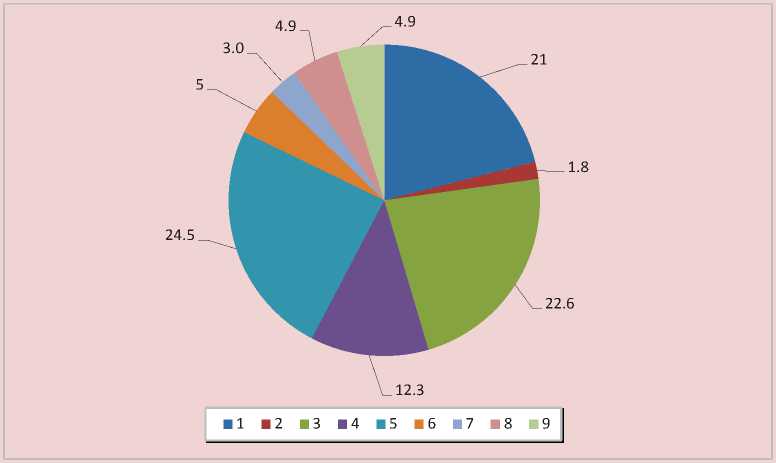
Economy types: 1. Regional (Republican) city-centers. 2. District city-centers. 3 . Cities and districts of oil and gas specialization in combination with deer breeding, and (or) agriculture. 4 . Cities and districts of mining specialization in combination with deer breeding and (or) agriculture. 5. Cities and districts of forestry and agricultural specialization. 6. Districts of deer, sheep and horse breeding, not included in the third and fourth economy types. 7. Ports and fish specialization. 8. Others, including closed administrative-territorial units. 9. Large cities with a diversified large-scale industry.
Let us formulate the content of such problems:
-
1. Unsatisfactory fulfillment of metropolitan functions by regional, national and district centers, uncertain limits for the population’s outflow from the periphery into centers and large cities, and difficulty of their maintenance at high cultural and scientific level, etc.
-
2. Uncertainty in the development of cities and districts of oil and gas and mining specializations, including in terms of their relationship with deer breeding and agriculture. With the “attenuation” of the activities of mining and oil enterprises the situation is critical for herders and workers of the service sector due to lower demand for their products and services.
-
3. Threats to the sustainable development of territories of forestry and agricultural specialization are observed not on the part of production, but also people’s welfare in forest settlements and villages. According to the logic of post-industrial development, the districts of deer, sheep and horse breeding that do not have cities and live a relatively autonomous life, often leading subsistence farming, should be transferred to the new technological and social basis, without interfering in the traditional way of life. It is very difficult to find the right solution.
-
4. Difficult situation in the fishing industry, which level of organization affects lives of more than 300 thousand people.
-
5. Problems of closed administrative-territorial units (CATU) in terms of their food and manufactured goods provision and the need to increase the share of local economy in this provision that would help the CATU
staff adapt to the harsh natural conditions of the North and the Arctic.
The geographically-complex problems of the North are connected with the organization of economic systems of three types, such as:
– “supportive” economical complexes (hubs) (there are 26 in the North), based on expendable resources; modernization should be focused on the already existing urban and rural settlements, housing and communal services, environmental protection, production and infrastructure;
– industrial periphery (53 small and medium-sized cities of the northern zone), based on mineral development and maintenance of infrastructure communications; it is, as a rule, settlements of cyclical development, which decay eventually becomes inevitable, unless there is a different basis of the economy;
– rural-type periphery (all settlements characterized by a rural way of life), which could enter the system “center – periphery” only in case of presence of certain infrastructure, namely: sustainable year-round transport connection with the use of, if necessary, river ways, floating (pontoon) bridges, roads, small aircraft; telephone, post and telegraph, cellular and television networks and the Internet by means of optic fiber and satellite communications; offices of multifunctional centers providing state and municipal services; fixed and mobile points of sale, medical and veterinary care; school education, if necessary, with the delivery to school by bus; regional courses for adult education (computer, technical, sanitary, medical, veterinary, etc.); mini-MTS (machine tractor stations) providing technical services to personal households and farms.
The distribution of the population by types of territorially-economic formations is shown in Figure 6 .
The authorities have to solve these territorial-sectoral and geographically-complex problems (it is so right!) within the boundaries of specific territorial-economic systems, which are in essence objects of program planning. These systems, as if lying on top of administrative boundaries, include intraoblast (intra-krai, intra-republic) economic areas. They are the structural units that are mandatory in the development of territorial planning schemes.
One hundred and four intra-oblast areas are allocated in the North, including 30 – in the European part (together with the Vologda Oblast they make 35; see Fig. 7), 13 – in the West-Siberian part, 32 – in the East-Siberian part, 29 – in the Far-Eastern part [4]. When the specifics of the North and the Arctic becomes crucial for making planning and design decisions, it becomes necessary to find a common basis for its accounting, which, in turn, requires the sharing of experience with those areas. Why do the intra-oblast areas that have similar economic capacity and natural conditions of development have considerably different social results?
We have divided intra-oblast areas as objects of spatial planning into four groups relative to the population dynamics. The results are as follows (tab. 2) .
Intraregional dynamics in all intra-oblast areas is negative, but in varying degrees. Greater resilience to socio-political conflicts is registered in cities with a population of over 100 thousand people: Arkhangelsk, Severodvinsk, Vologda, Cherepovets, Petrozavodsk, Syktyvkar, Ukhta – Sosnogorsk agglomeration, Surgut, Nizhnevartovsk, Bratsk, Yakutsk, Komsomolsk-on-Amur,
Figure 6. Distribution of the population of the North of Russia by types of territorial-economic systems in 2015, %
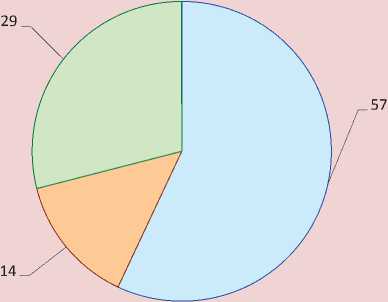
□ 1.Territorial-economic complexes
□ 2. Peripheral industrial centers
□ 3. Rural-type periphery
Table 2. Distribution of population by type of intra-oblast areas; the North in general = 100%*
|
Types of districts |
1990 |
2000 |
2010 |
2015 |
|
1. Stable population, population outflow is compensated by natural growth |
27 |
33 |
36 |
38 |
|
2. Population decline, population outflow is not compensated by natural growth |
49 |
48 |
47 |
47 |
|
3. Significant reduction in the population, negative migration and natural population decline |
14 |
13 |
11 |
11 |
|
4. Extremely negative migration with an organized relocation, in rural areas population ageing |
10 |
6 |
6 |
4 |
|
* Figures in the table were calculated by the author. |
||||
where industrial and transport enterprises are located, and some rural areas – a kind of enclaves with indigenous way of life. Singleindustry towns and areas such as Vorkuta, Inta, Kirovsk, Monchegorsk, Kostomuksha, Norilsk and others, and areas of logging and agriculture are less sustainable.
Figure 7 shows the intra-oblast areas of the European North. It can be seen that the areas and oblast and national centers replenish the diminishing population with the help of the births and to a large extent – with the help of internal migration from rural districts. The exceptions are Murmansk and other coastal settlements of the Murmansk Oblast; this fact shows that the situation concerning Russia’s functions in the Arctic is critical (fishing in the cold seas, maintenance of the Northern Sea Route, establishment of bases for development of the Barents Sea shelf, etc.).
The European North of Russia has the spatial characteristics of already developed areas; that is, with the established pattern of location of production and distribution of population. The region is marked by the diversity of forms of territorial organization of economy and population resettlement. The main direction of its development is to preserve and upgrade these forms on the basis of scientific and technological achievements, strengthening internal and inter-regional relations. The Asian North combines what has been developed and what is being developed, the “in depth” and “in breadth” types of development are combined as equivalent vectors of development.
In general it can be said that the modernization of existing facilities, construction of infrastructure on developed areas, increase in the standard of living and quality of life taking into consideration traditional activities of small-numbered peoples are the priorities in the development of productive forces in the North. The “development in breadth” fades into the background; paramount importance is attached to the “development in depth”. The movement from developed to new territories and water areas involves huge costs and requires time-consuming scientific and technical training.
The experience of studying the North shows that it is methodologically necessary to combine the theory of territorial development, program-target planning and the geo-systemic approach to identifying and addressing socioeconomic issues . The geosystem approach is that in which natural environment,
Figure 7. Example of the European North of Russia: characteristics of intra-oblast economic areas by population dynamics in 1990–2015
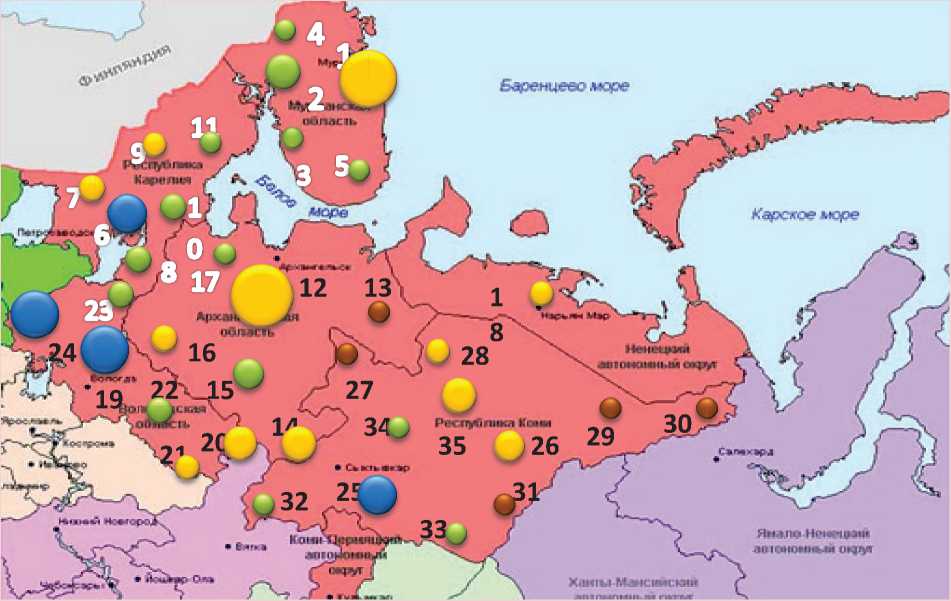
The numbers represent economic areas:
1 – Murmansky, 2 – Apatity-Monchegorsky, 3 – Kandalakshsky, 4 – Pechengsky, 5 – Kolsky (Lovozersky), 6 – Petrozavodsky, 7 – Sortavalsky, 8 – Medvezhiegorsky, 9 – West-Karelian, 10 – Segezhsky, 11 – North-Karelian, 12 – Arkhangelsky, 13 – Mezensky, 14 – Kotlassky, 15 – Velsky, 16 – Nyandomsky, 17, Onegzhsky, 18 – Nenetsky, 19 – Vologodsky, 20 – Velikoustyugsky, 21 – Totemsky, 22 – Kharovsky, 23 – the area near Sheksna, 24 – Cherepovetsky, 25 – Syktyvkarsky, 26 – Pechorsky, 27 – Udorsky, 28 – Ust-Tsilemsky, 29 – Intinsky, 30 – Vorkutinsky, 31 – Vuktylsky, 32 – South-Western (Priluzsky), 33 – Ust-Kulomsky, 34 – Knyazhpogostsky, 35 – Ukhtinsky.
The area of a circle is proportional to the population in 2015.
-
■ – stable population, population outflow is compensated by natural growth;
-
– population decline, population outflow is not compensated by natural growth;
-
■ – significant reduction in the population, negative migration and natural population decline;
-
■ – extremely negative migration with an organized relocation, in rural areas population ageing.
population, and production are considered jointly within a single territorial economic complex. The integration of natural and social systems of approximately the same dimension is methodologically quite legitimate. Our experience of comparing the quantitative measurements of physical-geographical provinces with the characteristics of the economy shows the possibility and usefulness of calculations of natural and natural-resource potentials and their input into the assessment of economic conditions.
If we take into account the limited financial and organizational resources of Russia and its regions, it is necessary to recognize the appropriateness of the use of program planning at the level of sub-region – geosystem within the boundaries of two–three subjects of the Russian Federation. These include, for example, Kola-Karelian, Dvina-Pechora, Ob-Irtysh. The geosystem character of large natural-economic regions like the Arctic, the Far and the Near North is rather conditional, truncated or artificial. For example, the North in general has only one sign of geosystem character – the territory of the watershed of the Arctic Ocean. In this case, the North needs to have a natural southern boundary along the line of world watershed. It is considered in such a way by hydrologists and sometimes by geologists but it is not consistent with common perceptions about the North and its problems of socio-economic development. Latitudinal natural-economic zones of Russia cannot act as program planning objects. Of course, the program for development of the Arctic is possible to work out, but it will be a nonconstructive document. And it is advisable to apply the program method of management not to the zones but to integrated territorial systems subordinated to specific administrative centers.
Список литературы Geosystem approach to socio-economic development in the regions of the north of Russia
- Dodin D.A. Ustoichivoe razvitie Arktiki (problemy i perspektivy) . Saint Petersburg: Nauka, 2005. 283 p.
- Dynkin A.A. Mezhdunarodnoe sotrudnichestvo v Artike: riski i vozmozhnosti . Vestnik RAN , 2015, vol. 85, no. 5-6, pp. 404-411.
- Laverov N.P. Osvaivat’ Arktiku slozhnee, chem kosmos . Redkie zemli , 2014, no. 3, pp. 40-48.
- Leizerovich E.E. Ekonomicheskie mikroraiony Rossii (setka i tipologiya) . Moscow: Trilobit, 2004. 128 p.
- Lukin Yu.F. Rossiiskaya Arktika v izmenyayushchemsya mire . Available at: http://arctic-and-north.com; http://narfu.ru/aan/(accessed December 25, 2012).
- Pilyasov A.N. Arkticheskoe Sredizemnomor’e: predposylki formirovaniya novogo makro-regiona . EKO , 2010, no. 12, pp. 54-75.
- Prostranstvo, lyudi, ekonomika Yugry. Sotsial’no-ekonomicheskaya transformatsiya Khanty-Mansiiskogo avtonomnogo okruga . Under the scientific editorship of S.S. Artobolevskii and O.B. Glezer. Moscow: Ekonomist”, 2007. 415 p.
- Selin V.S., Bashmakova E.P. Prioritety sovremennykh gosudarstvennykh strategii razvitiya arkticheskikh raionov . Region: ekonomika i sotsiologiya , 2013, no. 1, pp. 3-22

